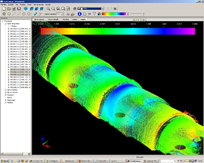We Present TcpScancyr for Tunnels
Generation of Tunnels cross-sections from 3D scanner
As data entry, horizontal alignments, elevation alignment and super elevation are defined, through numerical entry or by means of conversion of other commercial formats. The theoretical template of the tunnel can consist of several layers, by means of numerical entry or importing a DXF file. When these dates are defined information of the points collected by the scanner is added, by means of a set of coordinate files with or without RGB colour of every point.
The points can be examined with a 3-D view, with the possibility of changing to an orthogonal or a perspective view The camera´s position can be controlled directly over the horizontal alignment or in a relative position, allowing to modify the station and the height.
To obtain the profiles we specify the station´s range, the interval of generation, and the bandwidth to using. Optionally the filtration of the profiles can be activated to eliminate peaks. The program incorporates a powerful profile editor.
Once the profiles are calculated, they can be represented in 3D or with a frontal view. If the theoretical section has been defined, different colours are shown on the infra and over excavation zones, etc. The profiles can be exported to DXF in 2D or 3D, in an individual or whole form.
The program calculates automatically areas this information can be represented over the profile or generate a report of areas and volumes. Also the program can export the drawing to a DXF file, being able to set up the paper format, scales, options of representation, etc.
This application offers the user the simulation of the tunnel path, placing the user inside this one to a certain height and being able to control the position, speed, direction and range of the view.
More information




